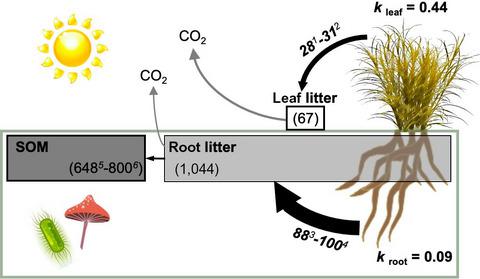Our official English website, www.x-mol.net, welcomes your feedback! (Note: you will need to create a separate account there.)
Worlds apart: Location above- or below-ground determines plant litter decomposition in a semi-arid Patagonian steppe
Journal of Ecology ( IF 5.5 ) Pub Date : 2021-05-17 , DOI: 10.1111/1365-2745.13688 Paula Berenstecher 1 , Patricia I. Araujo 1, 2 , Amy T. Austin 1
中文翻译:

天壤之别:地上或地下的位置决定了半干旱巴塔哥尼亚草原的植物凋落物分解
更新日期:2021-05-17
Journal of Ecology ( IF 5.5 ) Pub Date : 2021-05-17 , DOI: 10.1111/1365-2745.13688 Paula Berenstecher 1 , Patricia I. Araujo 1, 2 , Amy T. Austin 1
Affiliation

|
- While considerable attention has been devoted to how precipitation modulates net primary productivity in arid and semi-arid ecosystems, the emergence of multi-faceted controls on carbon (C) turnover suggests that there is much to be understood with respect to the mechanistic controls on plant litter decomposition.
- In the Patagonian steppe, we conducted a long-term factorial experiment, evaluating the importance of position, litter quality, tissue origin and soil resources on rates of C turnover under natural field conditions. Leaf and root litter of dominant grass species were placed in litterbags in different positions, on the soil surface and buried at 5-cm depth, with soil treatments of labile C, nitrogen (N) and their combination (C + N) over a 3-year period.
- As predicted, leaf litter decomposed significantly (nearly sixfold) faster above-ground than did root litter below-ground (p < 0.001). Surprisingly, root litter decomposed significantly faster than leaf litter above-ground (p < 0.001), and above-ground decomposition was not strongly affected by soil resource additions. Below-ground decomposition was largely determined by the interaction of litter quality and soil resource availability. Determining a C balance by integrating biomass allocation and primary productivity from this field site, combined with the data from this study, suggests large differences between the contribution of the above- and below-ground biomass to soil organic matter (SOM) pools and a long residence time of undecomposed root litter.
- Synthesis. Litter position clearly emerged as the predominant variable determining C turnover in this semi-arid steppe ecosystem, with litter quality and soil resources having significant, but more modest, effects. The near complete independence of above-ground litter decomposition from soil resources and rapid decomposition of surface litter, coupled with the counterintuitive relationships with litter quality, suggests that, in the long term, C loss from photodegradation may result in a minimal contribution of above-ground litter to SOM formation. These results have mechanistic implications for the distinct functionality of litter decomposition above- and below-ground in semi-arid ecosystems, and how these differential controls may alter the C balance due to future changes in climate and land use.
中文翻译:

天壤之别:地上或地下的位置决定了半干旱巴塔哥尼亚草原的植物凋落物分解
- 虽然人们对降水如何调节干旱和半干旱生态系统的净初级生产力给予了相当多的关注,但对碳 (C) 周转的多方面控制的出现表明,关于植物的机械控制还有很多需要理解的地方。垃圾分解。
- 在巴塔哥尼亚草原,我们进行了一项长期因子试验,评估位置、凋落物质量、组织来源和土壤资源对自然田间条件下碳周转率的重要性。将优势草种的叶、根凋落物置于垃圾袋不同位置、地表埋深5 cm,土壤处理为不稳定C、氮(N)及其组合(C+N)超过3 -年期间。
- 正如预测的那样,地上的树叶凋落物比地下的根凋落物分解速度显着(近六倍)快(p < 0.001)。令人惊讶的是,根凋落物的分解速度明显快于地上的叶凋落物 ( p < 0.001),并且地上分解不受土壤资源添加的强烈影响。地下分解在很大程度上取决于凋落物质量和土壤资源可用性的相互作用。通过整合该田地的生物量分配和初级生产力来确定碳平衡,结合本研究的数据,表明地上和地下生物量对土壤有机质 (SOM) 库的贡献与长期未分解的根系凋落物的停留时间。
- 合成。在这个半干旱草原生态系统中,凋落物位置显然是决定碳周转的主要变量,凋落物质量和土壤资源具有显着但更温和的影响。地上凋落物分解与土壤资源和地表凋落物的快速分解几乎完全独立,再加上与凋落物质量的反直觉关系,表明从长远来看,光降解造成的 C 损失可能会导致以上的最小贡献 -地面垃圾对 SOM 的形成。这些结果对半干旱生态系统中地上和地下凋落物分解的独特功能具有机械意义,以及这些差异控制如何因气候和土地利用的未来变化而改变碳平衡。


























 京公网安备 11010802027423号
京公网安备 11010802027423号